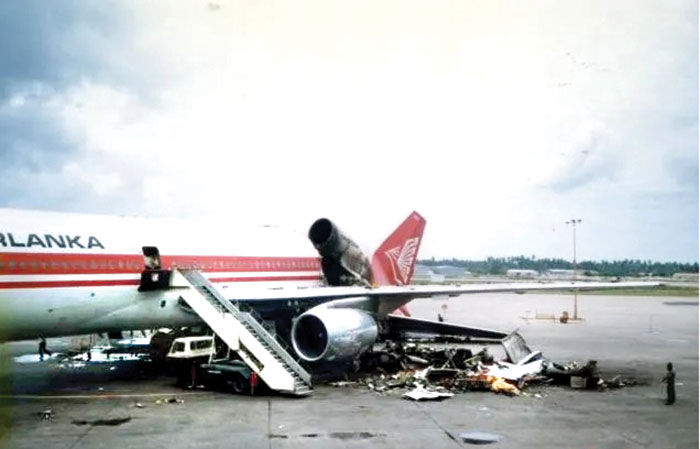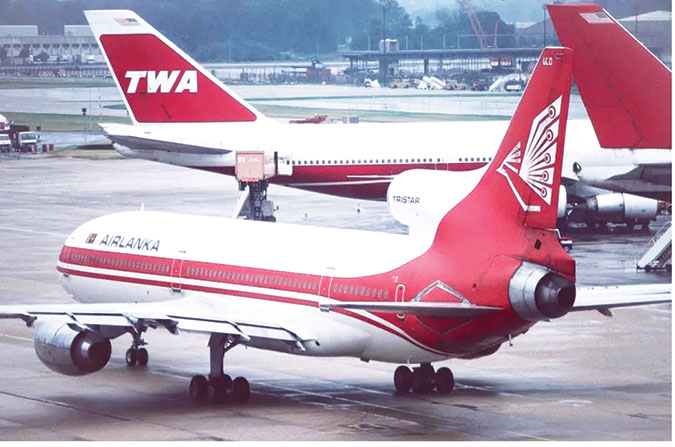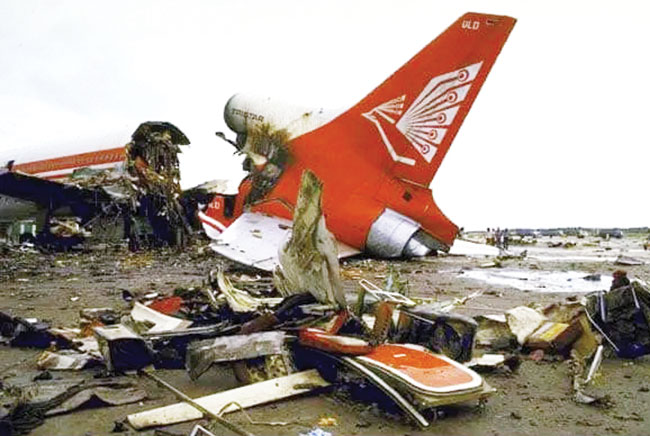Features
Blowing-up Air Lanka’s Tristar-36 on May 3, 1986

Explosives hidden in ‘fly-away-kit’ in cargo hold
by Menaka Akshi Fernando
“Every May 3, for the past 34 years, like a bunch of anxious surfers, we catch the rising wave of grief, glide on the intensifying emotions for a while and fall back to our senses as the wave of reality breaks. Although words can never remove the ache, I have worded this in memory of our dear friend Johann Chunchee who was killed that fateful day, and in honour of all my colleagues and other Air Lanka staff who survived the carnage”
On Saturday May 3, 1986, the Air Lanka Lockheed L1011 Tristar 4R-ULD named ‘City of Colombo’ arrived from London Gatwick via Zurich and Dubai to Sri Lanka. The aircraft which arrived as flight UL512 was on the tarmac at Bandaranaike International Airport (CMB/VCBI) Katunayake, preparing for the next sector as UL101 to Velana International Airport Malé, ((MLE/VRMM) in the Maldives Islands.
UL512 arrived late from DXB (1+ hours) giving the outbound crew minimum turnaround time. Chief Purser of UL101 Dushy Abeyesekera had a quick chat with the inbound Chief Rommel Paul about the cabin defects and the need for Paul and his crew to finish quickly so that they could board the passengers. Cleaning and catering were rushed as a result, as were the cabin crew’s prior to departure duties.
On board the aircraft were many French, German, British and Japanese tourists transiting en-route to the Maldives. Some were couples on their honeymoon, some looking forward to their diving expeditions and others simply looking forward to the sun, sand and sea.
Boarding of the flight was further delayed due to the aircraft being damaged during cargo and baggage loading. While this damage was being rectified, the cleaning staff were hastening their routine tasks.
It was 09:10 hours in the morning, 20 minutes before the scheduled departure of flight UL101. and Capt. Vasawa Sudhila Vasawath Vajirapani, First Officer Adrian Cramer and Second Officer Suhail Hashim were completing their pre-departure checks. Seated behind in the jump seat was supernumerary pilot Deepal Goonetillake. In the cabin were, Dushy Abeyesekera, Chief Purser, Leading Flight Attendants Amila Goonewardene, Jeanne Slojini Thurairatnam, and Neomal Jinadasa. The rest of the crew were Dyresh Fernando, Johann Chunchee, Michelle Balthazaar, Pearly De Silva, Lalinthi Wijesinghe, Helen Fernando, John Rukmal Perera and Mohan Kannangara.
Passengers were still boarding the aircraft and French navy officer Redato, a passenger who just boarded the aircraft, was getting ready to take his seat, when a massive explosion rocked the aircraft. Simon Ellis, a British passenger on board, felt as if everything was lurching forward. “The ceiling came down and our chairs were blown backwards. When I managed to climb over the chairs, I looked out and there was nothing” Ellis recalled.
The explosion was a time bomb! It was one of the darkest days in Sri Lanka’s Aviation history.
The Air Lanka jet at the site of the explosion. The tail section, on which an engine is mounted, was separated from the fuselage in the blast.
The powerful blast had ripped the aircraft in two, sending plumes of black smoke skyward. Most of the rear cabin was no longer there. Debris was falling from the plane and smoke was gushing out of the air vents. The impact had also shattered glass panels in the main terminal building. Parts of an aircraft door was found on the control tower.
Inside 4R-ULD, suddenly everything seemed quiet. For a brief moment things moved in slow motion. Nobody was screaming or crying. Then all hell broke loose!
Panic stricken passengers began to rush through the thick smoke to their closest exits. On one aisle a Flight Attendant was seen repeatedly asking passengers to remain calm and exit the aircraft, while on the other aisle passengers were tripping over each other and falling down the aircraft ‘boarding steps’.
4R-ULD L1011–100 was known as ‘City of Galle’ prior to June 1985, and later re-named as‘City of Colombo’
Everybody just wanted to get the hell out of there!
There were bodies lying on the tarmac amid cargo. There was meat and vegetables strewn over the area and one could not differentiate between body parts or food.
The response from the Fire Department was incredible. They promptly surrounded the aircraft and used foam and water to bring the fire down. The aircraft was being refueled at the time of the explosion, thus the danger of a secondary explosion was quite high. One of the refueling crew ran back to shut off the fuel valve to prevent further fuel leakage — an incredible presence of mind and courage!
The airport closed, and all arriving flights were diverted to regional airports.
The time bomb was planted in the aircraft’s ‘Fly-Away-Kit’ (FAK) which was uploaded to the C3 cargo hold and placed among the consignment of meat and vegetable crates — the regular exports to the neighbouring Maldivian archipelago. The flight was to have carried 128 people on UL101. It was clear during the investigations that the bomb had been timed to detonate mid-flight and had the flight taken off on time, all passengers and crew would have been killed.
The Sri Lankan government concluded that the bomb was planted by the Liberation Tigers of Tamil Eelam (LTTE). A search of the aircraft the next day uncovered a parcel containing uniforms with the insignia of the Black Tigers, the Commando wing of LTTE. Chief Purser Abeyesekera remembers seeing Black Tiger caps scattered on the tarmac straight after the explosion.
21 people were killed in the explosion, including three British, two German, three French, two Japanese, two Maldivians and one Pakistani. One Air Lanka cabin crew member, Johann Chunchee, also lost his life. Another 41 passengers were injured.
Capt Rohan Wijesinghe (extreme left) was walking to the B747 to operate a flight when the explosion occurred. He watched the tail section of 4R-ULD drop off. Here he poses with Capt Elmo Jayawardene (center) and Capt Sudhila Vajirapani (Captain of ill-fated UL101) moments before the explosion
A PERSONAL NOTE from Michael Roberts:
When my wife Shona and I were living in an annexe rented from Mrs Dorothy Kasman at Siebel Place, Kandy in the years 1966-70, a young couple in another annexe next door were the Chunchee family. Young Chunchee’s wife was of Burgher lineage and their young son was Johann. We did not kow them well but interacted in standard neighbourly fashion. I now recall that I heard of young Johann’s tragic death when I visited Sri Lankan in 1986 or 1987. it would have been a grievous body-blow to the Chunchee couple because I do not think they had other children. C’est la Vie!
SUBSEQUENT NOTE, 14 March 2022
The digital version of this article identified this photo as that of “Johann Chunchee” and Thuppahi initially carried that name. But Avishka Mario Seneviratne has indcated that the picture is that of an old Josephian, Basil Marcelline, who is alive and well in USA at present.
(From Michael Roberts’ Thuppahi blog)

